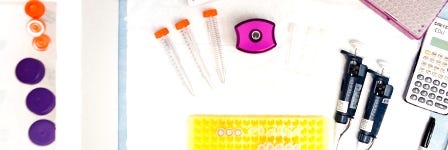How to Organize Your Lab Bench Space

As a scientist, you may spend hours at your lab bench every day. Organizing your lab bench so that you have an
uncluttered workspace with easily accessible reagents and tools is a great way to increase your efficiency in the
lab.
Here are some tips on organizing your lab bench space.
Keep pipettes and tips within reach.
Place pipettes on the side of your dominant hand on a stand, and place tip boxes within arm’s reach to the back of the bench on the side of your dominant hand. Only keep what you need on the working surface and store extra boxes elsewhere. Place waste bins on the side of your dominant hand for easy tip ejection.
Store solutions strategically.
Put solutions that you use daily on your non-dominant side. Store less-frequently-used solutions, including stock
solutions, on the upper shelves.
Stock reagents should be aliquoted to reduce the chance of source contamination. Ensure everything is labeled
with the contents, the date it was opened or aliquoted, and expiry date, if applicable.
See tips on organizing your lab stockroom >
Keep lab notebooks away from your central workspace.
To avoid damage from spills, keep your lab notebooks away from your primary workspace.
See tips for organizing your notebook, references, and protocols >
Create designated spots for general supplies.
Keep general supplies in dedicated locations in the lab so that you always know where to find items like markers, wipes, a calculator, scissors, and other supplies. Pro-tip: Add several rolls of different coloured tape to your supplies so you can colour code tubes and bottles.
Organize supplies based on how often you use them.
Keep racks and commonly used tubes easily accessible, either at the center back area of your bench or on the
shelf directly in front of you.
Confine miscellaneous items that you don’t use on a daily basis to the periphery of your central workspace or
the shelves. Group these items by experiment type so that you can access them all at once when you need them.
Label, label, label.
Once storage locations are decided, label the shelves and cupboards so you and your labmates know exactly where everything goes.
Perform regular audits.
Every few months, perform an audit of your lab bench. Do you need to stock up on any supplies? Are there any supplies you haven’t used in over 6 months? Consider storing these supplies away or putting them on a higher shelf to make room for materials you use more frequently.
For more tips on tidying your lab read our organizing tips for researchers and take the #TidyLab challenge >
References
- Guttman, C. (2013). Keeping Your Lab Organized. Retrieved from https://www.insidehighered.com



